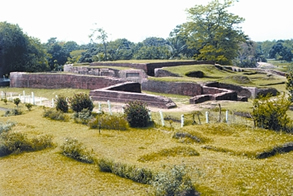Govinda Bhita
Govinda Bhita a high mound, traditionally ascribed to be the site of a Govinda temple and is located outside the northern rampart of mahasthinagarh (Pundranagar) of Bogra district. On its eastern and northern sides flows the moribund Karatoya. kn dikshit excavated the mound in 1928-29 and nazimuddin ahmed conducted a deep digging here in 1960. Excavations by Dikshit exposed two temple remains: one western and the other eastern. These belong to different periods and are enclosed within a 6-0 thick perimeter wall. The western temple, erected probably in the 6th century, is larger than the eastern smaller one, built about 11th century, partly on the ruins of the western temple. The western temple seems to have been built on a high central shaft, solidly filled with earth, and surrounded by three graded terraces, each buttressed by a series of blind cells packed with infilling of earth, intended to strengthen the foundation of a massive superstructure. Approach to this cellular podium was from the west.

The building remains on the eastern area revealed four periods of building and rebuilding; the latest is represented by a non-descript pavement of the Sultanate period from where 18 coins of the independent Sultans of Bengal were salvaged. The period from the top was represented by fragmentary walls of the late Pala period and the third period exposed a complex of walls and a polygonal stone pedestal of the early Pala period. The fourth and the earliest period revealed a square temple with 56 sides, having an altar in the centre, and surrounded by a procession path of the late Gupta period. These two temple complexes are situated on the high bank of the Karatoya, once a much larger river, they were thus exposed to annual inundation and scouring. As a precaution against the river's action, a series of elaborate paralled revetment walls and cross-walls were erected at different levels, including a 150 long semi-circular stonewall. However, this wall was completely swept away by the great flood of 1922 AD.
The deep digging revealed besides these successive period of building and rebuilding, a collection of punch marked coins and Northern Black Polished Ware (NBPW) of the Maurya period, half a dozen Sunga terracotta plaques (2nd-1st century BC), a carved blue schist disc shaped toilet tray (1st-2nd century AD), a clay seal and a terracotta Budhisattva head (4th century AD), three large earthen vats (6th-7th century AD) associated with lime-shells and a human skeleton. Other antiquities found were buttons, eardrops, pendants and nose-studs, figurines and toys of various materials and shape, ranging from terracotta to several varieties of semi-precious stones. Bronze and copper antimony rods, rings and bangles were also recorded to have been found in this site. [Ayub Khan]
